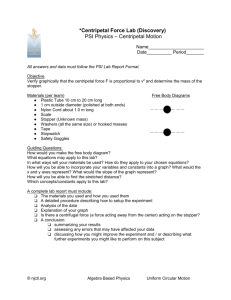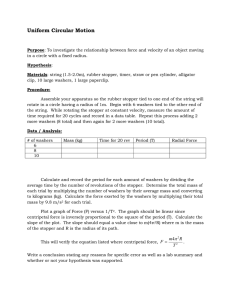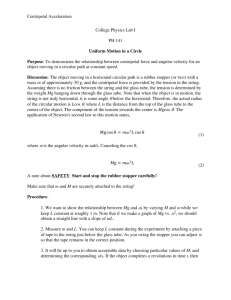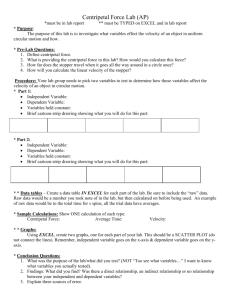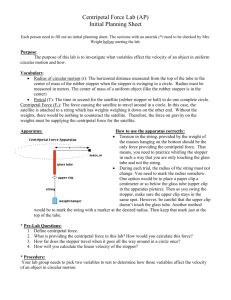Experiment 6: Centripetal Force
advertisement
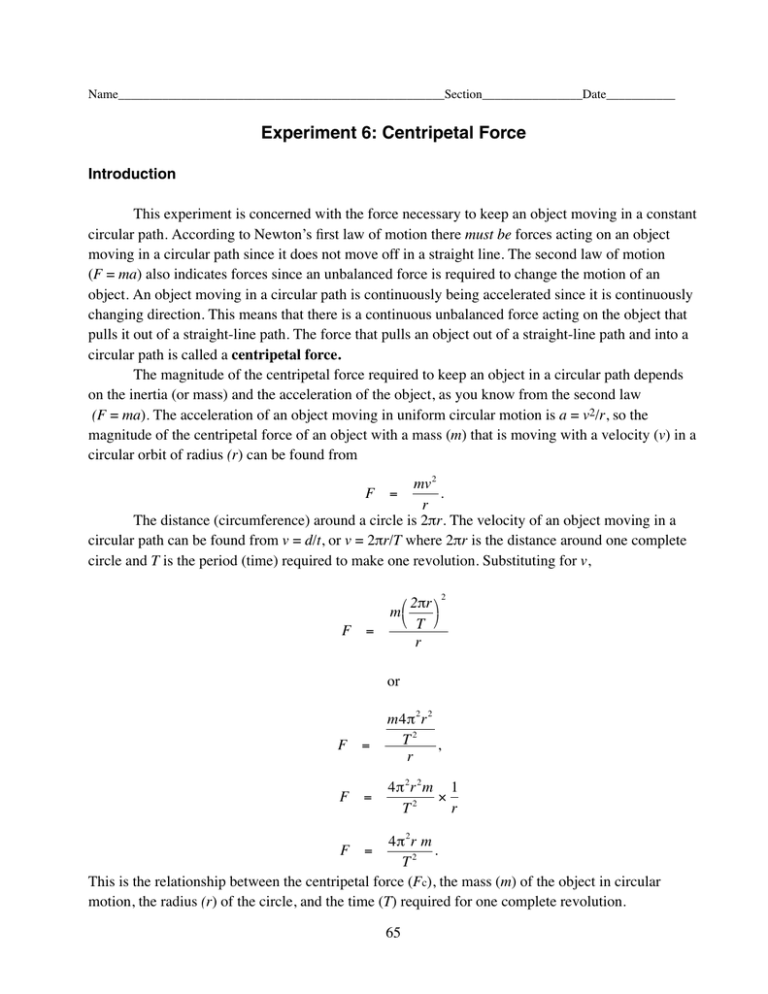
Name____________________________________________________Section________________Date___________ Experiment 6: Centripetal Force Introduction This experiment is concerned with the force necessary to keep an object moving in a constant circular path. According to Newton’s first law of motion there must be forces acting on an object moving in a circular path since it does not move off in a straight line. The second law of motion (F = ma) also indicates forces since an unbalanced force is required to change the motion of an object. An object moving in a circular path is continuously being accelerated since it is continuously changing direction. This means that there is a continuous unbalanced force acting on the object that pulls it out of a straight-line path. The force that pulls an object out of a straight-line path and into a circular path is called a centripetal force. The magnitude of the centripetal force required to keep an object in a circular path depends on the inertia (or mass) and the acceleration of the object, as you know from the second law (F = ma). The acceleration of an object moving in uniform circular motion is a = v2/r, so the magnitude of the centripetal force of an object with a mass (m) that is moving with a velocity (v) in a circular orbit of radius (r) can be found from mv 2 . r The distance (circumference) around a circle is 2πr. The velocity of an object moving in a circular path can be found from v = d/t, or v = 2πr/T where 2πr is the distance around one complete circle and T is the period (time) required to make one revolution. Substituting for v, F = F = 2πr m T r 2 or F = m 4π 2 r 2 T2 , r F = 4π2r 2 m 1 × T2 r 4π 2 r m . T2 This is the relationship between the centripetal force (Fc), the mass (m) of the object in circular motion, the radius (r) of the circle, and the time (T) required for one complete revolution. F = 65 Procedure 1. The equipment setup for this experiment consists of weights (washers) attached to a string, and a rubber stopper that swings in a horizontal circle. You will swing the stopper in a circle and adjust the speed so that the stopper does not have a tendency to move in or out, thus balancing the centripetal force (Fc) on the stopper with the balancing force (Fb), or mg, exerted by the washers on the string. r Plastic or glass tube (small diameter) (m) Stopper (m) Place clip here (F = mg) Washers (F mg) Figure 6.1 2. Place some washers on the string and practice rotating the stopper by placing a finger next to the string, then moving your hand in a circular motion. You are trying to move the stopper with a consistent, balancing motion, just enough so the stopper does not move in or out. Keep the stopper moving in a fairly horizontal circle, without the washers moving up or down. An alligator (or paper) clip placed on the string just below the tube will help you maintain a consistent motion by providing a point of reference as well as helping with length measurements. Be careful of the moving stopper so it does not hit you in the head. 3. After you have learned to move the stopper with a constant motion in a horizontal plane, you are ready to take measurements. The distance from the string at the top of the tube to the center of the stopper is the radius (r) of the circle of rotation. The mass (m) of the stopper is determined with a balance. The balancing force (Fb) of the washers is determined from the mass of the washers times g (Fb = mg). The period (T) is determined by measuring the time of a number of revolutions, then dividing the total time by the number of revolutions to obtain the time for one revolution. For example, 20 revolutions in 10 seconds would mean that 10⁄20, or 0.5 seconds, is required for one revolution. This data is best obtained by one person acting as a counter speaking aloud while another person acts as a timer. 66 4. Make four or five trials by rotating the stopper with a different number of washers on the string each time, adding or removing two washers (about 20 g) for each trial. For each trial, record in Data Table 6.1 the mass of the washers, the radius of the circle, and the average time for a single revolution. DataTable Table10.1 6.1 Data Trial Centripetal Force Relationships Mass of washers (m) Balancing force (F b ) Radius Time (r) (t) Centripetal force (F c) (kg) (N) (m) (s) (N) 0.02 1 __________ 2 __________ 3 __________ 4 __________ 5 __________ 0.04 0.06 0.08 0.10 0.20 __________ 0.39 __________ __________ __________ 0.59 __________ 0.78 __________ 0.98 __________ 0.10 __________ 0.15 __________ 0.17 __________ 0.20 __________ 0.25 __________ 0.02 __________ 0.53 __________ 0.48 __________ 0.44 __________ 0.46 __________ Mass of stopper __________________kg 67 0.6 0.22 0.42 0.58 __________ 0.82 __________ 0.93 __________ 5. Calculate and record the balancing force (Fb) for each trial from the mass of washers times g (9.8 m/s2), or Fb = mg. 6. Calculate and record the centripetal force (Fc) for each trial from F = 4π 2 r m . T2 Considering the balancing force (Fb) as the accepted value, and the calculated centripetal force (Fc) as the experimental value, calculate your percentage error for each trial of this experiment. Analyze the percentage errors and other variables to identify some trends, if any. Trial 1 : 0.22 − 0.20 × 100 = 10% 0.20 Trial 2 : 0.42 − 0.39 × 100 = 7.7% 0.39 Trial 3 : 0.59 − 0.58 × 100 = 1.7% 0.59 Trial 4 : 0.82 − 0.78 × 100 = 5.1% 0.78 Trial 5 : 0.98 − 0.93 × 100 = 5.1% 0.98 68 Results 1. Did the balancing force (Fb) equal the centripetal force (Fc)? Do you consider them equal or not equal? Why or why not? The balancing force and the centripetal force are basically equal. The balancing force creates the tension in the string which keeps the stopper moving in a circle. The data supports this since the error is less than 10%. 2. Analyze the errors that could be made in all the measured quantities. What was probably the greatest source of error and why? Discuss how these errors could be avoided and how the experiment in general could be improved. There are at least two major sources of errors: (a) time measurement, and (b) radius measurement The errors in the time measurement can be reduced by timing a number of revolutions and finding the average. The error in the radius measurement can be reduced by choosing a reasonable radius and marking it on the string. Then you will swing the stopper at such a rate to make the string stay at the mark. This also helps the student keep a constant speed throughout the timing process 3. Discuss any trends that were noted in your analysis of percentage error for the different trials. Analyze the meaning of any observed trends or discuss the meaning of the lack of any trends. There is more error when the time for a revolution is too long. This is because it is difficult to keep the stopper moving at a constant speed. Thus, as the hanging mass increases, and the time of revolution decreases, there will be less error. For the trial with a small hanging mass, it is best to make the radius small as well. This will reduce the time for a revolution and help keep the error down. 69 4. Was the purpose of this lab accomplished? Why or why not? (Your answer to this question should be reasonable and make sense, showing thoughtful analysis and careful, thorough thinking.) (The student should be able to explain the basics of centripetal acceleration. They should be able to explain how the centripetal acceleration (or centripetal force) changes when the radius changes or when the time of revolution changes. They should also understand that the tension; in the string, or indirectly the hanging weight, supplies the force needed to keep the stopper moving in a circle.) Invitation to Inquiry 1. Did you ever try to figure out which is a cooked egg and which is a raw one without breaking the shell? One way to accomplish this is by spinning the eggs on a plate, and the wellcooked one will continue to spin while the uncooked egg will rock back and forth. The yolk is heavier than the white, but why would an uncooked egg spin more slowly? Use your understanding of centripetal force to develop some ideas about why eggs should behave this way, then design a demonstration or experiment to test your idea. 2. Experiment with some things that rotate, such as rolling cylinders. Roll large, small, solid, hollow, and various combinations of large and solid cylinders, small and solid cylinders down an incline. Predict ahead of time which will reach the bottom of the incline first. Then test your predictions. 3. A hollow and solid cylinder of the same size do not have the same weight. If you roll the two cylinders down an incline slope together, side by side, the solid cylinder should win. Yet if you attach strings of equal lengths to make pendulums from the same hollow and solid cylinders, then you will find that they swing together, side by side. Is this true? Experiment to find out, then be prepared to explain your findings. 4. Explore relationships between mass distance from an axis and how hard it is to set an object into rotational motion. Consider using a baton with some kind of movable masses that can be fixed to the baton different distances from the axis of rotation. A large wooden dowel rod and lumps of clay might be a good experimental alternative to a baton. 70
